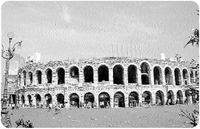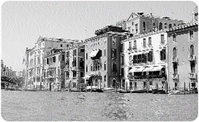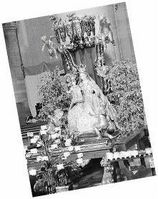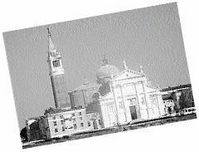From Verona to Venice
Published: Sunday | September 20, 2009

Laura Tanna
For years I've been hearing about the extraordinary experience of sitting in an ancient Roman arena, built 30 AD, vast enough to hold 25,000 people under a starlit sky, all witnessing grand opera, perhaps 'Carmen' or 'Turandot'. Dr Pamela George and her illustrious husband, the QC Emile George, were the first to describe to me their adventures in the northern Italian city of Verona, so when my brother-in-law, Suresh, invited us to join him to experience Aida, the tragic story of an enslaved Egyptian princess as interpreted by Giuseppe Verdi, the opportunity was too great to resist.
Verona has more magnificent Roman ruins than any city besides Rome, since it was colonised by Romans in 89 BC. From that period, Verona's oldest bridge, the Pietra, with five arches, spans the River Adige, which curves its way through the ancient city. Perhaps best known to many non-Italians as the setting for Shakespeare's famous Romeo and Juliet, whether the tale was based on fact or fiction, the city of Verona has thoughtfully provided signs - Casa di Giulietta - leading visitors through its streets to a picturesque marble balcony, perfect for a photo op.
peculiar water stands
I preferred visiting the Church of St Anastasia, an example of Italian Gothic architecture designed by two Dominican friars in the 13th century. People look for the two peculiar holy water stands, each supported by a carved hunchback, but as strange as these 15th century creations are, the soaring interior vaulted ceiling protects many lovely side chapels with beautiful paintings and altars. San Zeno Maggiore is an even better known ornate cathedral, with 48 bronze panels on its west doors and a campanile now standing 236 feet high, a city landmark.
Being so close to the vineyards near Verona which produce Soave, Bardolino and Valpolicella wines, Suresh ventured into the Enoteca St Anastasia, a fine wine store near the church, and soon fell into conversation with the delightful Sonia and Rolando Cesaro, proprietors of the establishment who insisted we sample some Loredan Gazzparinni sparking wine from Travere, a delicious end to an afternoon of sightseeing. To our amazement, Rolando still uses a 105 year-old National Cash Register for his business.
Italian printers
Then it was off to meet Gabriella and Martino Mardersteig, the Italian printers who did such a splendid production of Jackie Ranston's brilliant book, Belisario: Sketches of Character about the Jamaican-born artist whose renditions of Jonkonu are cultural treasures. Our hotel concierge found us a delightful restaurant just a few minutes from the arena so we dined outdoors at Trattoria Tre Marchetti where patron Roberto Barca greeted us most hospitably. Only then did we enter the arena and glimpse the magnificent stage, set with huge pillars and a stone backdrop befitting the drama to unfold. A lone figure in ancient Egyptian garb strode to mid-stage, suddenly struck a gong, and the audience was summoned, not once, not twice but thrice and then the performance began. Both the singers and orchestra were brilliant but when, near the end, torch lights held aloft by invisible soldiers streamed in from both sides of the upper arena, the effect was fantastic, almost as extraordinary as the realisation that we were sitting where once Christians, prisoners of war, gladiators and wild animals met their deaths in the name of entertainment for the masses.
Venice
While the drive from our hotel in Sirmione on Lake Garda to Verona was only 45 minutes, the drive from Verona to Venice was another two hours, but once there, our car went straight into the garage and it was only water taxis or walking in this sea-faring city built on little islands surrounded by a lagoon. History has it that the city was founded in the 5th century and developed in the 6th century when people on the mainland fled to the lagoon islands to escape armies from Lombardy to their west. The Fourth Crusade in the 13th century contributed to Venice becoming a great economic and political center in the 14th and 15th centuries. We've all heard how Marco Polo travelled to China, and it was from Venice! Today the spectacular waterfront palaces and churches built centuries ago provide incomparable settings, attracting visitors by the mega-thousands every year, so tourism is the city's economic lifeblood.
Piazzetta San Marco is the heart of Venice, where the winged lion of St Mark symbolises the city. The Doges' Palace greets one on the right, coming from the waterfront, while the Basilica of St Mark dominates the entire plaza with its ornate splendour. We'd taken guided tours of both these historic centres on a previous visit, as well as enjoying the Guggenheim Collection left to Venice as a museum of contemporary art by Peggy Guggenheim after her death in 1979. These are all must-sees for first time visitors, as is a boat ride to Murano to visit the fascinating studios where the famous hand-blown glass is created. We'd also visited the Gallerie dell'Accademia where one views Venice's largest art collection with all the grand masters who have depicted the city and religious themes over the centuries, artists such as Lotto, Veronese, Tintoretto and Titian as well as Carpaccio - all of this one must experience.
Having done that, there is nothing so rewarding in Venice as just walking its narrow streets, getting lost, finding one's way over the few bridges which connect the six ancient districts while looking into store fronts at the fabulous masks created for February carnival, or the exquisite stationery stores with marbled papers, or browsing through thoroughly modern art galleries or even stopping at one of many ice cream parlours or cafes. The traditional gondola ride can cost you US$100 for under an hour so many visitors just take the vaporetti or waterbuses, which stop along canals just as buses stop along roads.
unexpected treat
Dining in Venice turned out to be an unexpected treat. Splitting a Diavola pizza in the sidewalk Ristorante Omnibus literally canal-side was almost as much fun as lunch at the Hotel Danieli, but the view from their balcony Restaurant Terrazza Danieli overlooking the main lagoon where the Grand Canal begins is a stupendous sight. One feels as though one is inside one of those paintings of Venice. But the biggest surprise was dinner at Harry's Bar. We'd avoided it before, assuming that any bar once frequented by Ernest Hemingway, where the Bellini prosecco and fresh white peach juice cocktail was created, would have to be a tourist trap and first sight of the crowded, noisy bottom floor almost confirmed that impression. But in the restaurant upstairs we had the finest pasta of our entire week in Italy. The baked tagliolini au gratin with prosciutto was to die for! And the owner, the delightful Carmela Cipriani whose grandfather Giuseppe had founded the place, came to each table to greet her customers and regale us with stories of her famous Cipriani family and the hotel which bears their name but no longer belongs to them. But that's another story. Venice requires many visits just to scratch the surface of its rich culture and unique history.
Verona:
Arena of Verona Opera: www.arena.it
Trattoria Tre Marchetti: www.tremarchetti.it
Venice:
Restaurant Terrazza Danieli: www.terrazzadanieli.com
Ristorante Omnibus, www.ristoranteomnibus.com
Harry's Bar: www.Harry'sBar@cipriani.com

1: Verona's famous amphitheatre, from 30AD, once the arena where Christians, prisoners of war, gladiators and wild animals met their death in the name of entertainment for the masses. Now the home of world- renowned opera performances.- photos by Laura Tanna

2: Buildings along the Grand Canal of Venice.

3: An altar inside Verona's Gothic Sant'Anastasia church whose building began in 1290, designed by two Dominican friars.

4: Gondolas on one of the smaller canals in Venice.

5: San Giorgio Maggiore, originally a Benedictine convent from 982 AD and since 1951 the Giorgio Cini Foundation cultural center in Venice.
